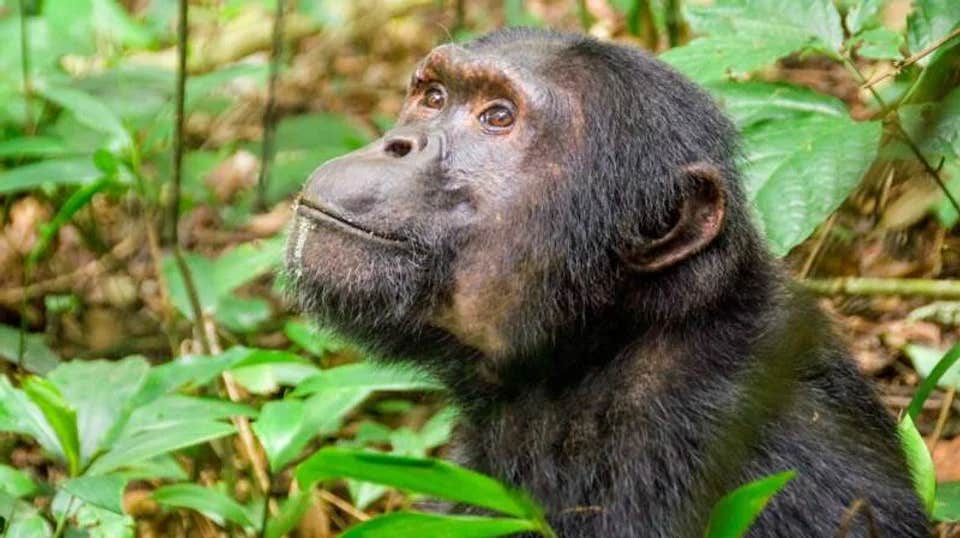How did early primate ancestors survive the asteroid led extinction of the dinosaurs?
Computer models, fossil records and information from living mammals revealed that most of the surviving mammals did not rely on trees.

A chimpanzee in Kibale National Park, Uganda. (Credit: Daniel J. Field)
Sixty-six million years ago, an asteroid impact led to the extinction of the dinosaurs and wiped out three-quarters of Earth's life forms. Amid this mass extinction, some early primate and marsupial ancestors, who lived in trees, managed to survive. A recent study has explored why these arboreal mammals were among the few to endure this catastrophic event.
Global deforestation caused by the wildfires from the asteroid's impact posed a significant threat to tree-dwelling species. However, using computer models, fossil records, and data from living mammals, the study revealed that most mammals that survived did not rely on trees. The few arboreal survivors, including human ancestors, may have adapted to the loss of trees with remarkable versatility.
This extinction event, known as the Cretaceous-Paleogene (K-Pg) boundary, played a crucial role in the early evolution and diversification of mammals.
"One possible explanation for how primates survived across the K-Pg boundary, despite being arboreal, might be due to some behavioral flexibility, which may have been a critical factor that let them survive," said Jonathan Hughes, a co-first author and doctoral student in the lab of Jeremy Searle, a professor of ecology and evolutionary biology at the College of Agriculture and Life Sciences. Jacob Berv, the other co-first author, is currently a Life Sciences Fellow at the University of Michigan.
Their study, "Ecological Selectivity and the Evolution of Mammalian Substrate Preference Across the K-Pg Boundary," was published in the journal Ecology and Evolution.
The earliest mammals appeared about 300 million years ago and likely diversified alongside an expansion of flowering plants approximately 20 million years before the K-Pg event. When the asteroid struck, many of these mammal lineages perished. "At the same time, the mammals that did survive diversified into all the new ecological niches that opened up when dinosaurs and other species became extinct," Hughes explained.
Related Stories
To conduct their research, the team used published phylogenies—branching, tree-like diagrams showing evolutionary relationships among organisms. They classified each living mammal into three categories based on their habitats: arboreal, semi-arboreal, and non-arboreal. They also developed computer models to reconstruct the evolutionary history of mammals.
Mammal fossils from around the K-Pg period are rare and difficult to use for determining an animal's habitat preference. Therefore, the researchers compared information from living mammals with available fossils to provide additional context for their findings.
The models generally indicated that most surviving species were non-arboreal during the K-Pg event, with two notable exceptions: ancestors of primates and marsupials. The models consistently showed that primate ancestors and their closest relatives were arboreal right before the K-Pg event. Marsupial ancestors were found to be arboreal in half of the model reconstructions.
The researchers also studied how mammalian habitats evolved over time. "We were able to see that leading up to the K-Pg event, around that time frame, there was a big spike in transitions from arboreal and semi-arboreal to non-arboreal," Hughes said. This suggests that many species were rapidly shifting away from tree-dwelling lifestyles.
The research team included Daniel Field, a vertebrate paleontologist at the University of Cambridge; Eric Sargis, a professor of anthropology at Yale University; and Stephen Chester, an associate professor of anthropology at Brooklyn College.
This study highlights the adaptability of early mammalian ancestors in the face of drastic environmental changes. Their ability to survive and diversify after such a significant extinction event underscores the importance of behavioral flexibility in evolution.
Note: Materials provided above by The Brighter Side of News. Content may be edited for style and length.
Like these kind of feel good stories? Get The Brighter Side of News' newsletter.



